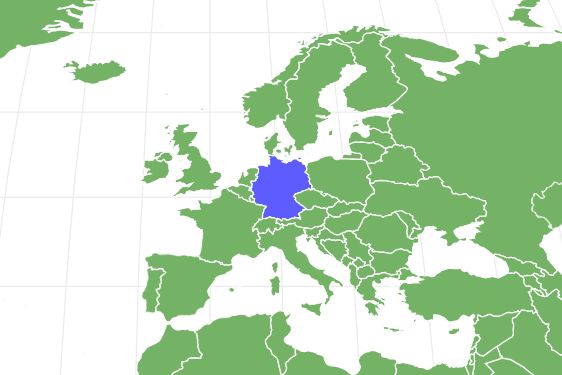Leonberger
Canis lupus
This dog has been used for pulling carts full of goods.
Advertisement
Leonberger Scientific Classification
- Kingdom
- Animalia
- Phylum
- Chordata
- Class
- Mammalia
- Order
- Carnivora
- Family
- Canidae
- Genus
- Canis
- Scientific Name
- Canis lupus
Read our Complete Guide to Classification of Animals.
Leonberger Conservation Status
Leonberger Facts
- Name Of Young
- puppy
- Fun Fact
- This dog has been used for pulling carts full of goods.
- Most Distinctive Feature
- the dog's temperament
- Temperament
- gentle and calm
- Diet
- Omnivore
Leonberger as a Pet:
- General Health
- Energy Level
- Shedability
- Trainability
- Intelligence
- Tendency to Chew
- Size
- Family and kid friendliness
- Yappiness / Barking
- Moderate
- Separation Anxiety
- High
- Preferred Temperature
- Average climate
- Exercise Needs
- High
- Friendly With Other Dogs
- High
- Pure bred cost to own
- $2,000
- Dog group
- Working
- Male weight
- - lbs
- Female weight
- - lbs
This post may contain affiliate links to our partners like Chewy, Amazon, and others. Purchasing through these helps us further the A-Z Animals mission to educate about the world's species.
View all of the Leonberger images!
They’re sometimes called Leos because they appear to have a mane like a lion.
The Leonberger breed goes back to the 18th century. Originally bred as companion dogs in Germany, they’re descended from the Newfoundland, longhaired Saint Bernard, and Great Pyrenees which are sometimes called the Pyrenean Mountain dog. They’re classified in the working group because they were once used to pull carts of goods as well as guard homes.
See all of our expert product reviews.
This dog’s mix of strength and intelligence is why it’s used as a rescue dog. It helps to find people who are lost and/or injured in the mountains and other perilous locations. A household with kids will find this dog’s gentle nature and playful behavior a welcome addition to the family.

The 6 Different Types of Leonbergers and Leonberger Mixes
Leonberger mix with other breeds:
- Leonberger Husky
- Leonberger Afghan Hound
- Leonberger Bernese Mountain Dog
- Leonberger German Shepherd
- Leonberger New Foundland
- Leonberger Bull Mastiff
3 Pros and Cons of Owning a Leonberger
| Pros! | Cons! |
|---|---|
| Protective personality: This breed is loyal. It keeps a close watch on its home and family members. | Lots of loose hair: This dog sheds lots of hair throughout the year. |
| Fun for kids: They have a gentle nature and love to romp around and play with kids. | Grooming is a must: Because of its heavy shedding, this breed needs daily grooming. |
| Adventurous: Families who like to go camping, swimming, or on other adventures would be a great match for this dog that loves the outdoors. | A large food budget needed: A large dog like this one needs a lot of food to supply it with energy. The price of dog food each month may be a drawback for some owners. |
Origins
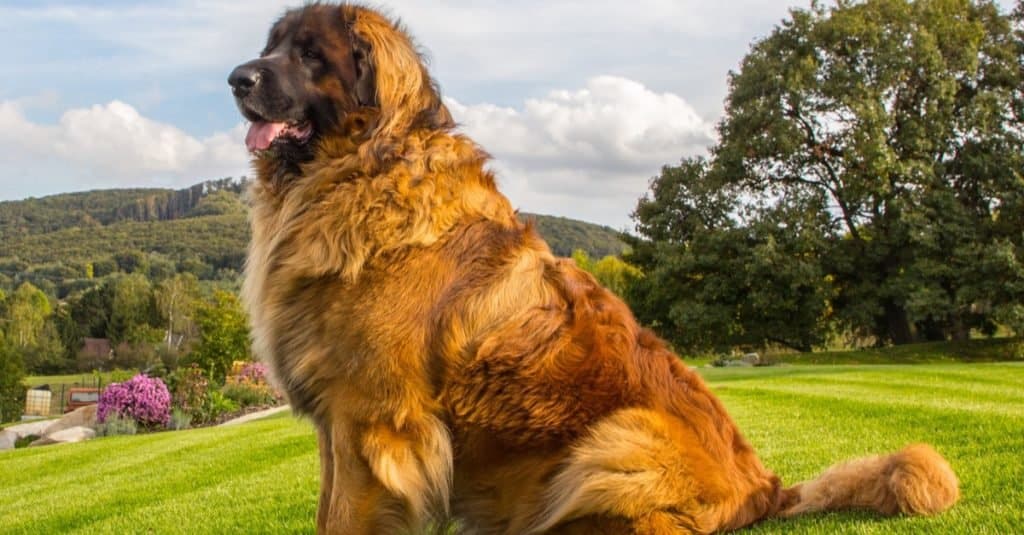
Leonbergers were once used to pull carts in Bavaria and also lived with European royalty as pets
©Peter Josto/Shutterstock.com
Large, with an agility which belies its size, the Leonberger is the offspring of two other large breeds: the Newfoundland and the St Bernard. The Newfoundland started out earning its keep working with fishermen, in Newfoundland. Along with its fishing boat duties, this cousin of the Labrador retriever and the Irish water spaniel also earned renown for its courage and its steadfastness in rescuing its human friends. The St Bernard on the other hand worked as a rescue operative for the Great St. Bernard Hospice in the heights of the Pennine Alps.
Health and Entertainment for your Leonberger
See all of our expert product reviews.
It was the breeder Heinrich Essig, of Leonberg, Germany who was inspired to create a breed which would be a worthy companion of royalty, in the 1800s. His efforts yielded fruit when royalty from all over Europe came seeking his brand new regal breed. Included in that list were the Prince of Wales, the Empress of Austria, and Umberto I, King of Italy. But not every Leonberger got to live a pampered lifestyle being fed the choicest cuts of meat. Others had to earn their keep as watchdogs or putting their impressive size and strength to use tugging carts.
During World Wars I and II Leonbergers were employed pulling ammunition carts during both armed conflicts. As a result, they nearly became extinct on both occasions. Following the Second World War only eight Leonbergers remained. Thanks to assiduous breeding efforts by Otto Josenhans and Karl Stadelmann, the breed was saved from the brink of extinction and was recognized by the American Kennel Club in 2010.
Size and Weight
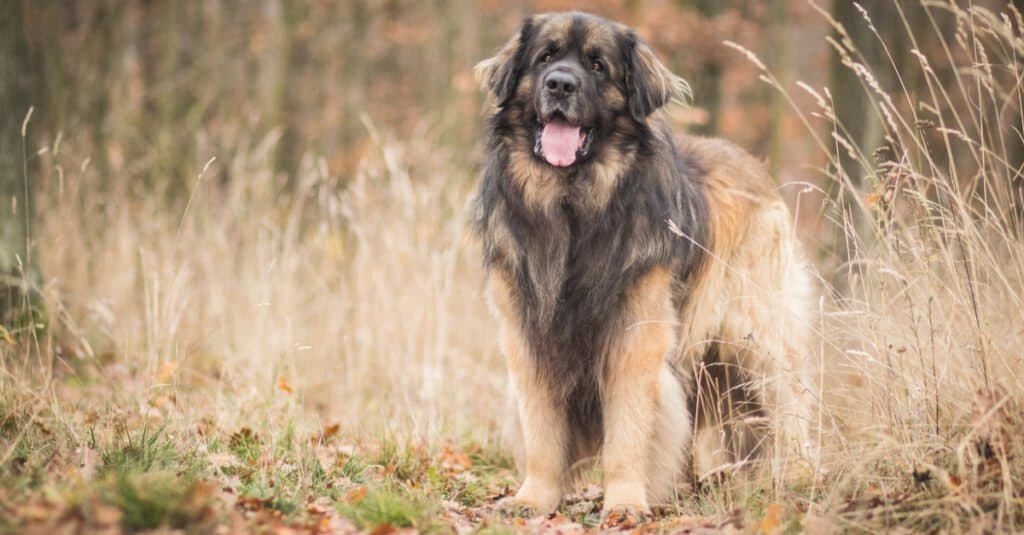
©AnetaZabranska/Shutterstock.com
This is a large breed of dog with a double coat of thick hair. An adult male achieves a height of 31 inches at the shoulder and a grown female’s height is 30 inches. When fully grown, a male has a weight of as much as 180 pounds, and a female 140 pounds. When they reach eight weeks old, these puppies have an average weight of 22 pounds. They are considered adult-size at 18-22 months.
| Weight (Male): | 180 pounds |
| Weight (Female): | 140 pounds |
| Height (Male): | 31 inches |
| Height (Female): | 30 inches |
Common Health Issues
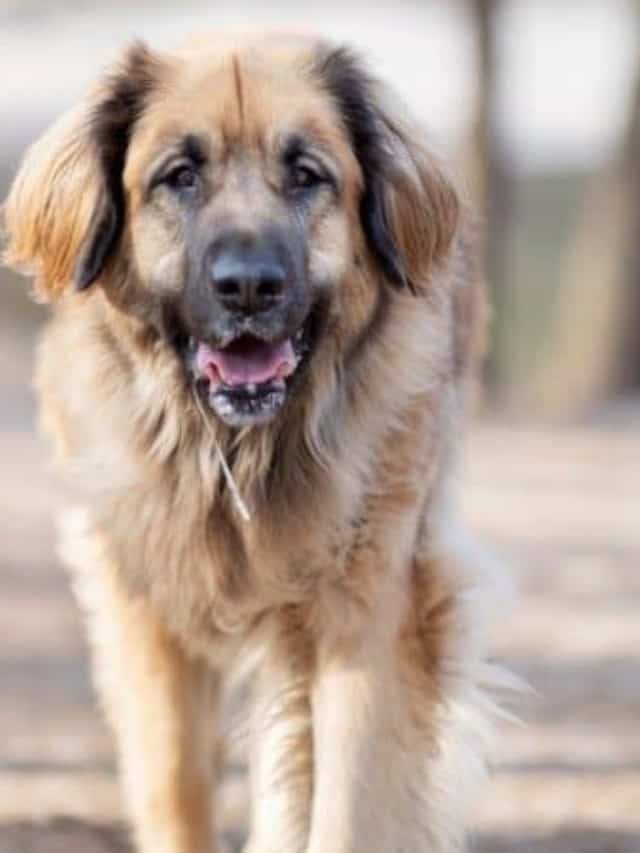
Leonbergers are particularly prone to bloat and hip dysplasia
©iStock.com/AngelaBuserPhoto
This pet has health issues commonly seen in other large breeds of dogs. One example is called bloat. This happens as a result of a dog taking in too much air, food, or water. Signs of bloat are a distended abdomen, drooling, whining, and retching. It is serious and the dog should be taken to a vet for care immediately. Some owners use a special bowl that distributes small amounts of food, so their dog isn’t able to gulp down food too quickly.
Hip dysplasia also affects some dogs of this large breed. It is essentially a hip joint that is out of alignment. It can cause lameness and pain for a dog. A vet may recommend weight loss, medication, or surgery if it’s an extreme case. Elbow dysplasia is the misalignment of the elbow joint. It can cause pain and lameness as well. Physical therapy, medication, and surgery are all treatments a vet may recommend.
Its most common ailments:
- Bloat
- Hip dysplasia
- Elbow dysplasia
Temperament & Behavior
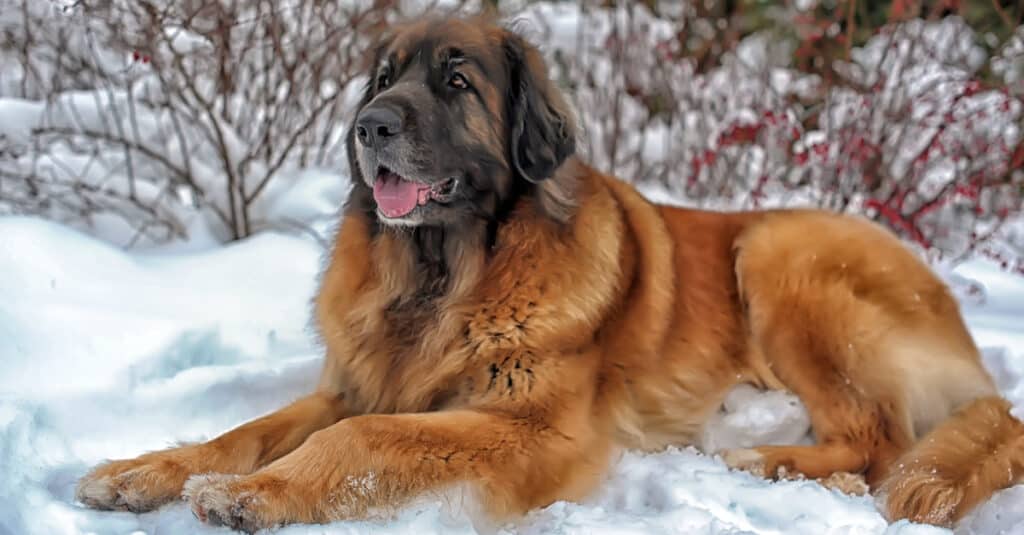
Leonbergers are gentle giants with the ability to get along well with children and other pets
©Anna Krivitskaya/Shutterstock.com
Though this dog is large in both height and weight as well as strong, its behavior is best described as gentle. They are known to be calm and compatible with children. These dogs become very attached to their family. Loyalty is just one of the traits that owners love about this canine.
These canines get along with other dogs and enjoy being a part of whatever game is going on in a household. Their playful personality makes them fun pets to have around!
How to Take Care of a Leonberger
Taking thorough care of this pet means considering its diet, grooming, and exercise needs. A Leonberger puppy and an adult dog have their requirements to keep them feeling good. Check out the facts on the care of this pooch.
The Best Dog Food for Leonbergers
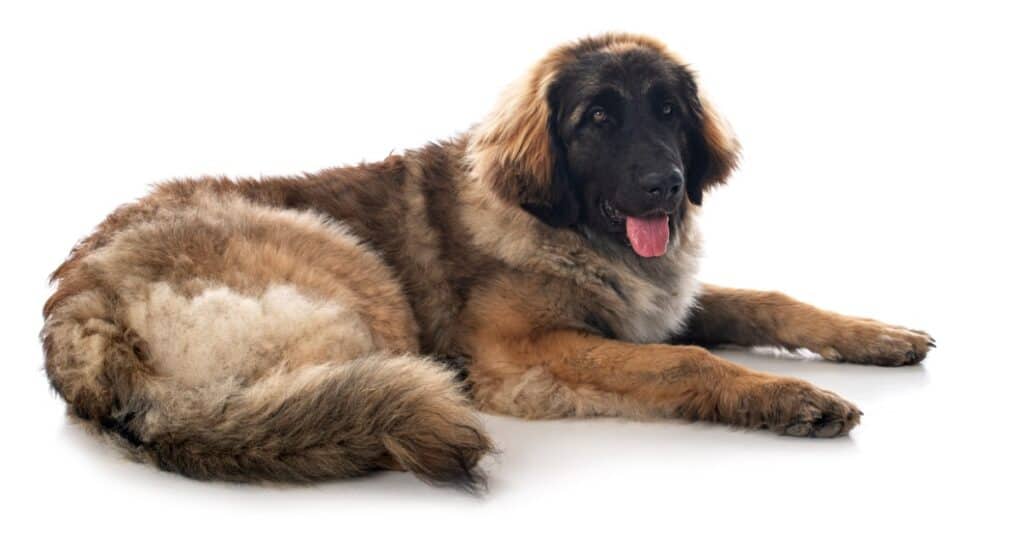
Adult Leonbergers are active and as a result, require lean protein to enable them to enjoy healthy muscles and joints
©cynoclub/Shutterstock.com
Leonberger puppies have nutritional needs that are different from fully grown dogs. Feeding this breed the right nutrients can be the key to maintaining its health.
Leonberger puppy food: Protein such as lean chicken, turkey and brown rice in this puppy’s diet lends nourishment to its growing muscles, joints, and tissue. Vitamin E and Omega 6 fatty acids both support its coat and skin health. This puppy burns carbohydrates in its food to give it energy for its daily antics. It’s best to feed puppies three or four small meals spread through the day. This keeps their energy up so they can explore as puppies do!
Leonberger adult dog food: This active dog needs lean protein like chicken, lamb, and turkey to continue to enjoy healthy muscles and joints throughout its lifespan. Remember, hip dysplasia is a concern for this breed so protein is essential in its bowl. While there is less fat than protein in quality dog food, fat is necessary to give an adult dog energy for the day’s activities. Vitamin C helps the dog’s immune system to head off disease and illness. Glucosamine is important for maintaining healthy joints.
Bloat is another health issue for this dog. It’s a good idea to space out meals and exercise and divide one portion of food in half and feed the dog one half at a time. That helps the dog to avoid taking too much air into its stomach by eating a large amount of food too fast.
At A-Z Animals, we think the best dog food for Leonbergers is Purina Pro Plan With Probiotics Shredded Blend High Protein, Digestive Health Adult Dry Dog Food.
Made from real beef, this recipe is the best of both worlds- high protein and easily digestible. Supplemental chicken and fish ingredients deliver glucosamine to protect the joints from wear and problems like hip and elbow dysplasia. There are live probiotics, which contribute to smooth digestion and immunity.
Here’s where to get Purina Pro Plan High Protein Digestive Health Shredded Blend with Probiotics on Chewy and Amazon.
- High protein beef and rice formula dry dog food
- Probiotics to support digestive and immune health
- Vitamin A and omega-6 fatty acids for healthy skin and coat
Maintenance and Grooming
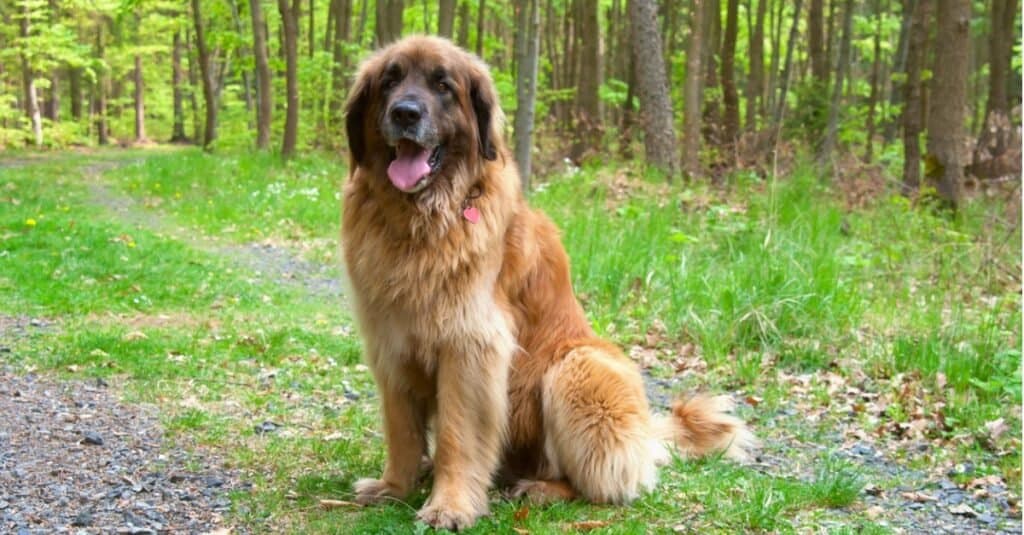
Leonbergers shed heavily and require daily brushing with an undercoat rake to loosen tangles in the fur closest to their skin
©Kaca Skokanova/Shutterstock.com
How much does a Leonberger shed? They are heavy shedders. Not only do they shed a large amount of hair regularly, but their shedding activity also increases with the change of seasons.
Proper grooming care must include daily brushing. It’s recommended an owner use a tool called an undercoat rake to remove tangles from the hair located closest to the dog’s skin. A slicker brush is the best tool for working through the upper or outer coat to remove debris, mats, and tangles.
Professional breeders will tell you that grooming care takes at least 30 minutes because of the thickness of the dog’s coat. Be sure to pay special attention to the hair behind the dog’s ears and on the backs of its legs. These are two locations that tend to attract tangles.
Another essential task to take care of during the grooming routine is to trim the dog’s nails. This is done every two weeks.
Training
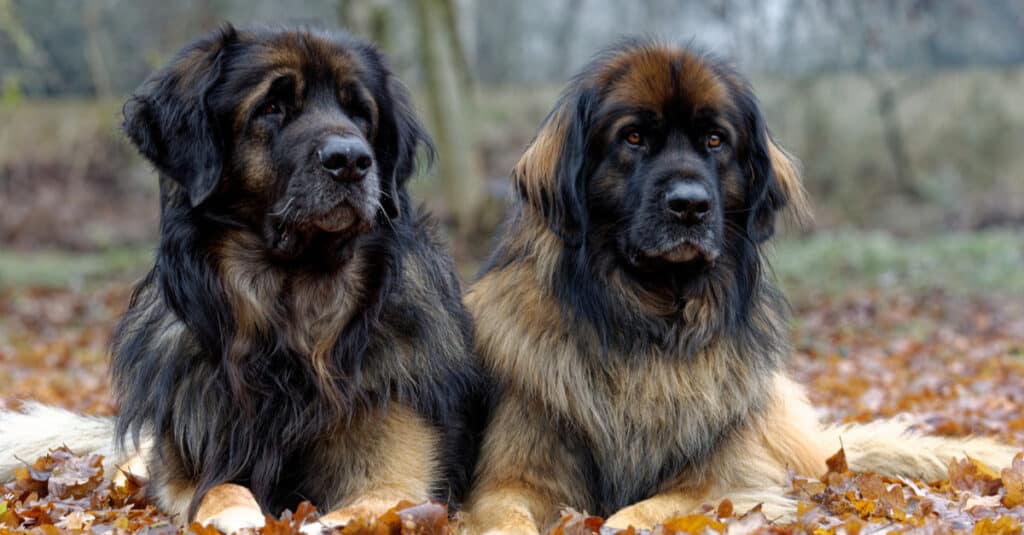
Leonbergers are intelligent, sociable with other canines, and excellent swimmers
©Colin Seddon/Shutterstock.com
Because they are smart and eager to please, training this dog is a fairly easy task. An effective program of obedience training is necessary for a dog of this size.
Exercise
One of the basic facts about the care of this breed is it needs 60 minutes of exercise daily. They mix well with other dogs so a dog park is a good thought. If the dog is fully trained, taking it to the woods for an off-leash run would be fun. Taking the dog to a lake or a pond would be a real treat. These dogs are dedicated swimmers!
This is not a good breed of dog to own if you live in an apartment.
Puppies
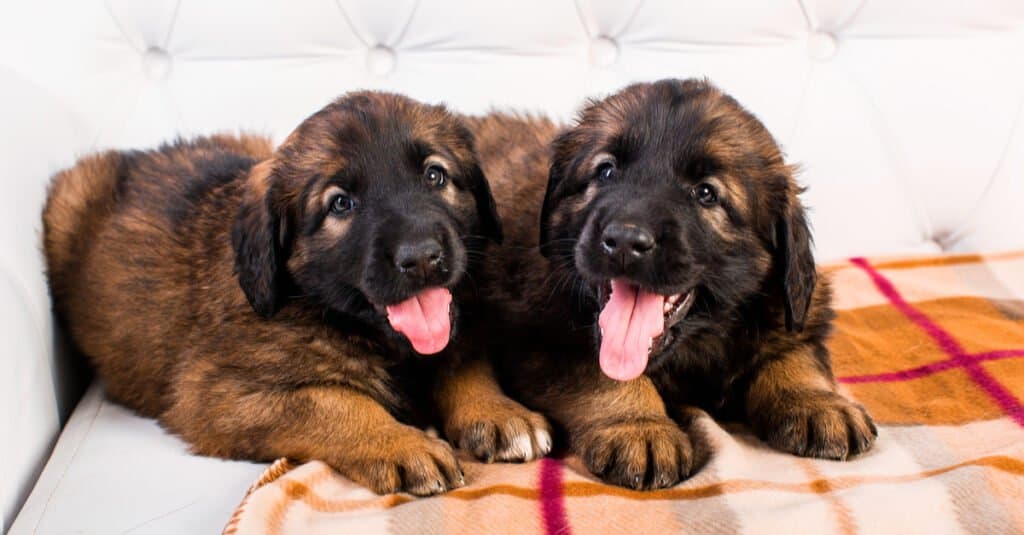
©Akbudak Rimma/Shutterstock.com
Socialization is essential for any dog, but it’s especially important for a breed of this size. Socialization as a puppy teaches a Leonberger not to jump up on people, bark excessively, etc. This process requires taking these puppies to different environments and allowing them to interact with people of different ages.
Children
The especially large size of this canine means it should be monitored while spending time with children. Despite having a friendly temperament and being fond of kids, the size of this dog puts very small children at risk of being bumped into or knocked down. A socialized Leonberger is more aware of how to behave around kids and adults.
Dogs Similar to Leonbergers
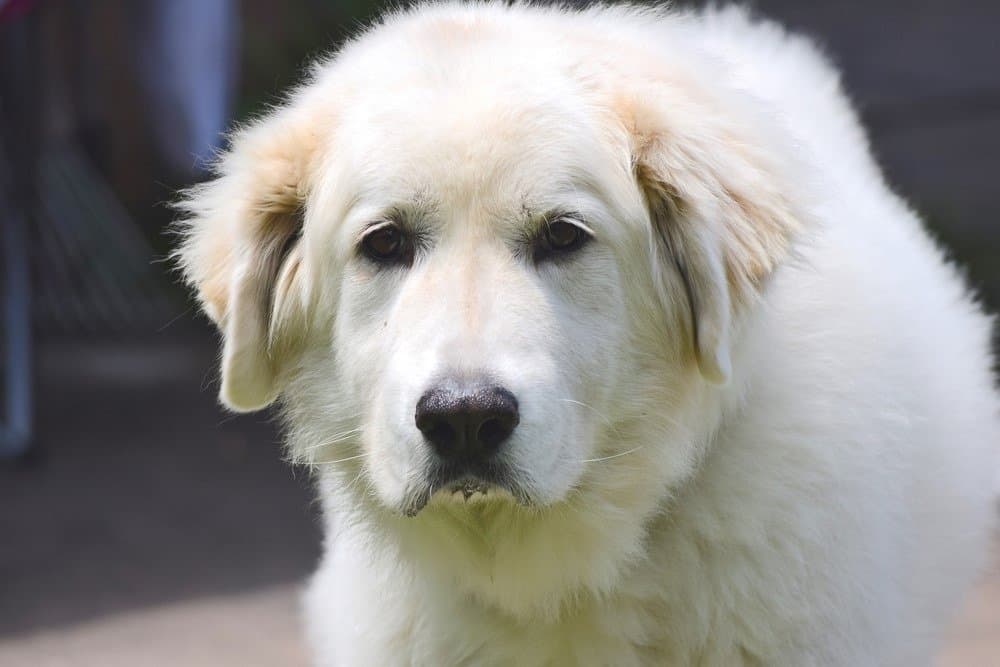
Great Pyrenees are similar in size to Leonbergers although the latter weigh more
©Ggeek/Shutterstock.com
The Great Pyrenees (Pyrenean Mountain Dog), longhaired Saint Bernard, and Newfoundland are all similar breeds to the Leonberger.
- Great Pyrenees-This breed and the Leonberger are about the same height, however an adult Leonberger has a higher weight. The Leonberger’s coat has a wide variety of colors whereas a Great Pyrenees is white.
- Longhaired Saint Bernard-This breed and the Leonberger are about the same size in terms of height. But, a male longhaired Saint Bernard can have a higher body weight. Both are accomplished rescue dogs!
- Newfoundland-Both breeds have a sweet, affectionate temperament. Looking at size, the Leonberger is larger than this breed in both weight and height.
Popular Names for Leonbergers
Popular names for this large breed:
- Cleo
- Ginger
- Sammy
- Persis
- Sassy
- Max
- Samson
- Charlie
Leonberger FAQs (Frequently Asked Questions)
What is a Leonberger?
This large breed of dog originated in Germany. They descend from the longhaired Saint Bernard, the Great Pyrenees (Pyrenean Mountain Dog), and Newfoundland. These dogs can grow to be equal in weight to the average human. Despite being very large, they have a sweet personalities and are loyal to their family. Many owners think of their Leonberger as a gentle giant. Not surprisingly, they are used as rescue dogs.
One of the facts to think about when considering this breed is its size. This is a large dog that needs lots of space to exercise its muscles and get its heart pumping. Also, its thick coat needs daily care.
Is a Leonberger the biggest dog?
Yes and no. When it comes to weight, a Leonberger seems to be the largest breed weighing around 180lbs. But, in terms of height, a male Irish Wolfhound can be at least 32 inches tall at the shoulder.
How much does a Leonberger cost?
Breeders sell these puppies at a price of around $2000.
The annual cost for vet care ranges from $700 to $1000 for this breed.
As expected, the food budget is a bit higher for this dog than for smaller breeds. Food adds up to a price of $90 to $100 per month.
Do Leonberger dogs shed?
Yes, they are big shedders. This is one of those facts responsible breeders mention to potential owners.
Is a Leonberger a good first dog?
No. Though these dogs have lots and lots of positive qualities, they are a big commitment to make for the average family choosing the first dog.
As an exception, a family with a large farm would be more likely to enjoy success with this breed as their first dog.
What is the lifespan of a Leonberger?
The lifespan of this breed is seven to ten years.
Are Leonberger dogs friendly?
Yes. A friendly personality and gentle temperament are two of the most favorable characteristics of this breed.
What is the difference between a Newfoundland and a Leonberger?
The main differences between Leonbergers and Newfoundlands are origin, coat color, head shape, temperament, and swimming motion.
What is the difference between Estrela Mountain Dog and Leonberger?
The Estrela Mountain Dog is a stubborn but gentle guardian known for its thick outer coat, which is similar to goat hair. It’s smaller than the affectionate and loyal Leonberger, but it can also live up to four years longer.
Thank you for reading! Have some feedback for us? Contact the AZ Animals editorial team.
Sources
- Wikipedia, Available here: https://en.wikipedia.org/wiki/Drafting_dog
- American Kennel Club, Available here: https://www.akc.org/dog-breeds/great-pyrenees/
- Hill's Pet, Available here: https://www.hillspet.com/dog-care/dog-breeds/leonberger
- Preventive Vet, Available here: https://www.preventivevet.com/dogs/help-my-dogs-stomach-is-bloated-understanding-canine-bloat-torsion-and-gdv

